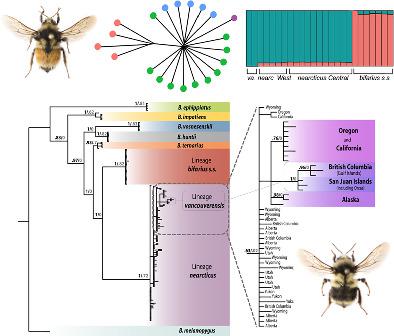当前位置:
X-MOL 学术
›
Syst. Entomol.
›
论文详情
Our official English website, www.x-mol.net, welcomes your
feedback! (Note: you will need to create a separate account there.)
Substantial genetic divergence and lack of recent gene flow support cryptic speciation in a colour polymorphic bumble bee ( Bombus bifarius ) species complex
Systematic Entomology ( IF 4.7 ) Pub Date : 2020-01-15 , DOI: 10.1111/syen.12419 Guillaume Ghisbain 1 , Jeffrey D. Lozier 2 , Sarthok Rasique Rahman 3 , Briana D. Ezray 4 , Li Tian 3 , Jonah M. Ulmer 4 , Sam D. Heraghty 2 , James P. Strange 5, 6 , Pierre Rasmont 1 , Heather M. Hines 3, 4
Systematic Entomology ( IF 4.7 ) Pub Date : 2020-01-15 , DOI: 10.1111/syen.12419 Guillaume Ghisbain 1 , Jeffrey D. Lozier 2 , Sarthok Rasique Rahman 3 , Briana D. Ezray 4 , Li Tian 3 , Jonah M. Ulmer 4 , Sam D. Heraghty 2 , James P. Strange 5, 6 , Pierre Rasmont 1 , Heather M. Hines 3, 4
Affiliation

|
Phenotypic polymorphism can constitute an inherent challenge for species delimitation. This issue is exemplified in bumble bees (Bombus), where species can exhibit high colour variation across their range, but otherwise exhibit little morphological variation to distinguish them from close relatives. We examine the species status of one of the most abundant North American bumble bees, Bombus bifarius Cresson, which historically comprised two major taxa, bifarius s.s. and nearcticus. These lineages are recognized primarily by red and black variation in their mid‐abdominal coloration; however, a continuum from black (nearcticus) to red (bifarius s.s.) variation has led to their historic synonymization. Integrating mitochondrial and nuclear data and whole‐genome sequencing, we reveal a high level of both mitochondrial and nuclear divergence delimiting two morphologically cryptic species – the red bifarius s.s. and the colour‐variable (black to red) nearcticus. Population genomic analysis supports an absence of recent genomic admixture and a strong population structure between the two clades, even in sympatry. Species distribution models predict partially differentiated niches between the genetically inferred clades with annual precipitation being a leading differentiating variable. The bifarius s.s. lineage also occupies significantly higher elevations, with regions of sympatry being among the highest elevations in nearcticus. Our data also support a subspecies‐level divergence between the broadly distributed nearcticus and the island population vancouverensis. In this paper, we formally recognize the two species, Bombus bifarius Cresson and Bombus vancouverensis Cresson, the latter including the subspecies B. vancouverensis vancouverensis comb.n. and B. vancouverensis nearcticus comb.n., with vancouverensis the name bearer due to year priority.
中文翻译:

显着的遗传差异和近期基因流的缺乏支持颜色多态性熊蜂( Bombus bifarius )物种复合体的神秘物种形成
表型多态性可以构成物种定界的固有挑战。这个问题在熊蜂 (Bombus) 中得到了例证,其中的物种在其范围内可以表现出很大的颜色变化,但在其他方面表现出很少的形态变化以将它们与近亲区分开来。我们研究了北美最丰富的熊蜂之一 Bombus bifarius Cresson 的物种状况,它在历史上由两个主要分类群 bifarius ss 和 Nearcticus 组成。这些谱系主要通过腹部中部颜色的红色和黑色变化来识别。然而,从黑色 (nearcticus) 到红色 (bifarius ss) 的连续变化导致了它们的历史同义化。整合线粒体和核数据以及全基因组测序,我们揭示了高水平的线粒体和核发散,界定了两种形态学上的隐秘物种——红色 bifarius ss 和颜色可变(黑色到红色)近海藻。种群基因组分析支持最近的基因组混合物的缺乏和两个进化枝之间的强大种群结构,即使是在同一位置。物种分布模型预测遗传推断进化枝之间部分分化的生态位,年降水量是主要的区分变量。bifarius ss 谱系也占据了显着更高的海拔,其中有同情的地区是近海口中海拔最高的地区。我们的数据还支持广泛分布的近海龟和温哥华岛种群之间的亚种水平差异。在本文中,我们正式认识了这两个物种,Bombus bifarius Cresson 和 Bombus vancouverensis Cresson,后者包括亚种 B. vancouverensis vancouverensis comb.n。和 B. vancouverensis Nearcticus comb.n.,由于年份优先,vancouverensis 成为名称承载者。
更新日期:2020-01-15
中文翻译:

显着的遗传差异和近期基因流的缺乏支持颜色多态性熊蜂( Bombus bifarius )物种复合体的神秘物种形成
表型多态性可以构成物种定界的固有挑战。这个问题在熊蜂 (Bombus) 中得到了例证,其中的物种在其范围内可以表现出很大的颜色变化,但在其他方面表现出很少的形态变化以将它们与近亲区分开来。我们研究了北美最丰富的熊蜂之一 Bombus bifarius Cresson 的物种状况,它在历史上由两个主要分类群 bifarius ss 和 Nearcticus 组成。这些谱系主要通过腹部中部颜色的红色和黑色变化来识别。然而,从黑色 (nearcticus) 到红色 (bifarius ss) 的连续变化导致了它们的历史同义化。整合线粒体和核数据以及全基因组测序,我们揭示了高水平的线粒体和核发散,界定了两种形态学上的隐秘物种——红色 bifarius ss 和颜色可变(黑色到红色)近海藻。种群基因组分析支持最近的基因组混合物的缺乏和两个进化枝之间的强大种群结构,即使是在同一位置。物种分布模型预测遗传推断进化枝之间部分分化的生态位,年降水量是主要的区分变量。bifarius ss 谱系也占据了显着更高的海拔,其中有同情的地区是近海口中海拔最高的地区。我们的数据还支持广泛分布的近海龟和温哥华岛种群之间的亚种水平差异。在本文中,我们正式认识了这两个物种,Bombus bifarius Cresson 和 Bombus vancouverensis Cresson,后者包括亚种 B. vancouverensis vancouverensis comb.n。和 B. vancouverensis Nearcticus comb.n.,由于年份优先,vancouverensis 成为名称承载者。









































 京公网安备 11010802027423号
京公网安备 11010802027423号